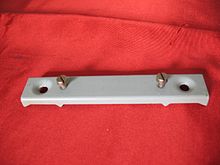W 49
The desk / wall telephone W 49 , called "Ti-Wa W 49", is an analog telephone that was used from 1949 by the Hanseatic Apparatebau-Gesellschaft Neufeldt & Kuhnke ( Hagenuk ) in Kiel for the Deutsche Post in the western occupation zones and from 1950 was developed and manufactured for the Deutsche Bundespost.
The W 49 was built exclusively by Hagenuk. In 1967 the W 49 was replaced by the newly developed "FeWAp 61" telephone set . Like all telephones of that time, the W 49 works with the pulse dialing method for automatic telephone exchange .
casing
The special thing about the W 49 is that it can be used both as a desk phone and as a wall phone. To convert from a desktop to a wall-mounted unit, the fork and the number switch housing are repositioned by 180 °. As a wall-mounted device, the W49 is attached to the wall in a special holder with its stable metal base plate.
When the W 49 is screwed together as a tabletop device, at first glance it hardly differs from the W 48 . The telephone receiver , the fork, the number switch (NrS 38) and the electromechanical inner workings are identical except for the slightly different hook switch . However, the base plate of the W 49 has three additional holes, two for the wall bracket and one for the cable entry. The bracket for holding the clipboard, the supply line, the telephone receiver cable and the two housing screws also had to be shortened compared to the W 48 due to the convertibility of the device. Another difference to the W 48 is that there are two signs for the phone number. One is attached to the front of the housing and one below the fork carriage.
Since the Deutsche Bundespost was skeptical of the design of the W 49, only a few production orders for the construction were awarded to Hagenuk. Since this is made of the very hard, but brittle and fragile thermoset plastic Bakelite , many specimens broke or were badly damaged very quickly due to careless handling. The W 49 was a device that was more likely to be used in workshops or in commercial premises, i.e. it was often used in dirty, dusty surroundings. For all of these reasons, this phone is less common today than other models of the time.
Colors and variants
Like the W 48 and W 38, the W 49 was made of black or ivory-colored Bakelite. It is very rarely available in other colors such as gray or dark red, with the housing parts and the handset made of melamine resin and not of Bakelite.
The bakelite used in the ivory-colored devices was - in contrast to the black bakelite - not very light-resistant and also more fragile, which is why many ivory-colored devices were quickly damaged over time and also faded almost snow-white. Since the production of ivory-colored thermoset was more complex and expensive, these devices were considered a status symbol. They were only made available by the post for a higher fee. Another (non-convertible) wall mounted device is the wall mounted device W 51 ("stag beetle"). This is both optically and technically almost identical to the “W 48-Wall” and its direct predecessor, the “W 38-Wall”.
Like most dialers, the W 49 was also available in various technical variants; In addition to the standard version, it was also manufactured with an earth button , switchable indicators, switchable alarm clock or in a version for an A2 circuit .
| abbreviation | meaning |
|---|---|
| W 49 | Standard version |
| W 49 mT | with earth / flicker button |
| W 49a | A2 circuit |
| W 49a mT | A2 circuit and earth / flicker button |
| W 49a Sz | A2 circuit and switchable indicator |
| W 49a uSz mT | A2 circuit, switchable indicator and earth / flicker button |
See also
- Roller connector - ADo ZB27
- Junction box (telephone)
- Junction box
- Telephone desk set
- Telephone socket / plug
- Drum selector
- Crouching dog


